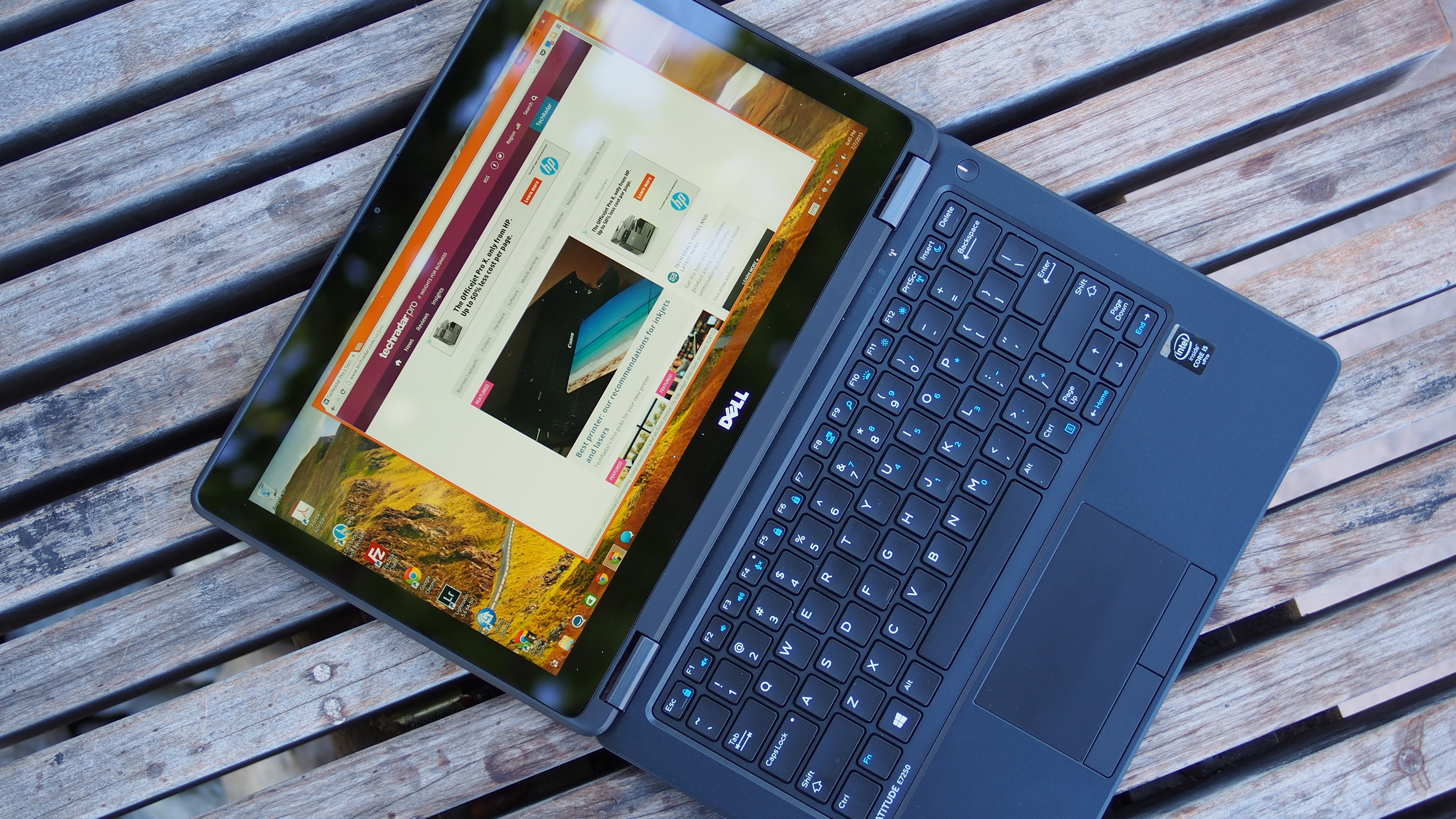Why you can trust TechRadar
Pricing for the Latitude 12 7000 Series (E750) start at $1,079 (£703, AU$1,451). At that price, users will get an Intel Core i3 processor, 4GB RAM and a 128GB solid state drive. The price quickly rises when you're upgrading to a more powerful processor, adding RAM and boosting the storage during configuration.
The Latitude 12 7000 Series can also be configured with optional WiGig support. This enables support for the Dell Wireless Dock ($269, £175, AU$361). With the wireless dock, you can connect your peripherals – like a keyboard, mouse, display, hard drives and printers – without requiring a hard connection to the dock. You can also place the wireless dock off your desk and free up space.
Here's how the Dell Latitude 12 7000 Series (E7250) sent to TechRadar Pro was configured:
Specifications
- Processor: 2.3GHz Intel Core i5-5300U (dual-core, up to 2.9GHz with Turbo Boost)
- Graphics: Intel HD Graphics 5500
- Storage: 256GB SSD
- Memory: 8GB RAM
- Display: 12.5-inch, 1920 x 1080 10-point touchscreen, 360-nit anti-fingerprint (16:9) WLED
- Camera: 720p HD webcam for WiGig
- Connectivity: Intel tri-band 802.11ac Wi-Fi, WiGig, Bluetooth 4.0; 4G LTE WWAN optional
- Operating system: Windows 8.1 Pro 64-bit
- Ports: HDMI, Ethernet, three USB 3.0, Mini DisplayPort, headphone, TPM, Smart Card reader. Optional NFC Smart Card reader and fingerprint scanner.
- Weight: 2.99 pounds (1.36kg)
- Dimensions: 12.2 x 0.79 x 8.3 inches
The cost dramatically jumps to $2,573 (£1,676, AU$3,457) when the Dell Latitude 12 7000 Series is configured with the highest specifications – Intel Core i7 Broadwell processor, 16GB RAM and 512GB SSD. Neither this top-shelf configuration nor the one we received for review come with premium Dell software add-ons.
Performance
The dual-core Intel Core i5 Broadwell processor on the Latitude 12 7000 Series (E7250) performs as expected. Applications and files open quickly, and even multitasking with multiple Chrome tabs open didn't slow the system down.
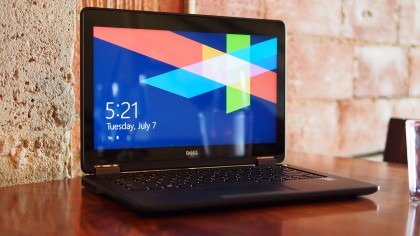
Lacking a dedicated graphics processor, the integrated Intel HD 5500 graphics will feel anemic to creative professionals working with large video and photo files. Business users who want to play fast action games with high frame rates on their downtime may also want to steer clear of this compact Ultrabook, but the Latitude can handle most computing tasks with ease. For more graphics-heavy tasks, you'll want to look at heavier mobile workstations instead.
Benchmarks
3DMark: Fire Strike: 540, Sky Diver: 2234, Cloud Gate: 4154
Cinebench: CPU: 267; GPU: 20 fps
PCMark 8 Work: 3383; Battery life: 4:55:58
Even though benchmarked performance of the Latitude is within range of similarly equipped systems, Dell's 2015 XPS 13 performed better on a graphics-heavy test with similar GPU, CPU and RAM configurations. The XPS 13 posted higher GPU and 3DMark scores than the Latitude, but slightly lower 258 CPU score using Cinebench.
Although the Lenovo ThinkPad T450s that we reviewed comes with an Intel Core i7 Broadwell chip, processing performance on the Latitude is stronger. The Lenovo delivered a CPU score of 249, but beats the Latitude on GPU performance with 24 fps. ThinkPad also fared better on the 3DMark tests, posting results of 731, 5305 and 2648 for Fire Strike, Cloud Gate and Sky Diver, respectively.
While I didn't notice any slow downs during normal operations with the Latitude, I found that the system was slower to shut down than most other notebooks, including the HP EliteBook Folio 1020 G1 and the Lenovo ThinkPad T450s. Since the Latitude ships with a relatively clean build of Windows 8.1, save for a few Dell apps, it's unclear why the Latitude takes a few seconds longer to power down.
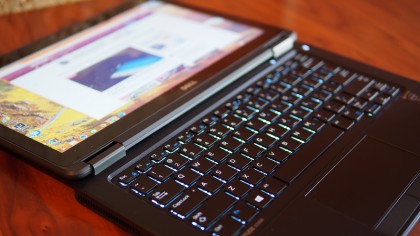
The Intel Core i5 processor on the Latitude generates a bit of heat. Most of that heat is felt on the top left corner of the laptop, but this doesn't affect its "lapability," as the bottom of the notebook still runs cool. The main issue with heat is that when the fan kicks in, fan noise is louder than the Lenovo ThinkPad T450s.
Battery life
The Latitude 12 lives up to Dell's claims of all-day computing. Despite packing in a more powerful Intel Core i5 processor compared to the MacBook's Intel Core M, the Latitude 12 7000 Series (E7250) is equipped with a 4-cell battery that lasted more than nine hours of daily use.
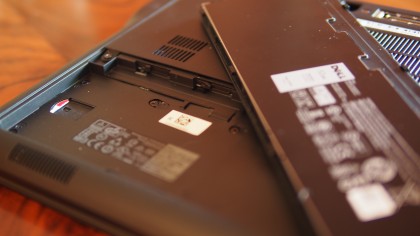
For users in the field and away from a power outlet, the Latitude comes with a removable battery, so you can swap a depleted battery for a fresh one if you need more power. Dell also offers an external battery pack in the form of the Dell Power Companion. These are similar to battery packs that charge cell phones on the go.
Even though you can swap out a dead battery for a new one, unlike the Lenovo ThinkPad X250, the Latitude doesn't come with an internal bridge battery. This means that when you swap out your battery, you'll have to save your work, power down, replace the battery, power up and re-open and reload all your application and data. This can be a nuisance if you're a heavy multitasker with multiple windows and tabs that need to be re-opened.
Enterprise security and features
Dell also offers optional contactless NFC smart card reader, Smart Card reader, fingerprint scanner, TPM, FIPS-certified hardware crypto accelerator, Dell Control Vault, Computrace and Dell Data Protection Encryption. The Latitude 12 7000 Series comes with a one-year subscription to Dell Data Protection Security Tools and Protected Workspace.
DDP Encryption protects data across all endpoints, including external media and public cloud storage, while DDP Protected Workspace works to stop malware while the DDP Security Tools provides advanced authentication.
Dell also provides advanced BIOS management capabilities. This gives IT administrators the ability to manage the BIOS remotely. This feature competes with the SureStart self-healing BIOS technology on HP's EliteBook Folio 1020 G1 notebook. The difference is that Dell allows remote BIOS management, whereas HP's technology allows the BIOS to autonomously repair itself with a stored copy in the event of a malware attack.
To ensure that your company's data doesn't fall into the wrong hands if the laptop is lost or stolen, IT managers can also remotely wipe the laptop's drive even if the Latitude is powered off.
The Latitude 12 comes with a three-year standard warranty. Dell also offers optional enhanced warranty services through ProSupport and ProSupport Plus packages. Both packages come with SupportAssist software that routinely scans your system for malfunction.
In the event of a system failure, a ProSupport agent will contact the customers proactively, a move that Dell claims will shorten your downtime as you don't have to wait in line for service or send your laptop to a depot for diagnostics. The Plus option adds next business day on-site repair service, meaning that Dell will send a technician to wherever you're located to diagnose and fix the problem. Additionally, ProSupport agents can handle technical questions, help you setup your home network and even assist in troubleshooting third-party hardware and software. For a small business owner, it's like having an IT staff on call.
Display
It's surprising to see that the maximum resolution available for the Latitude 12 7000 Series (E7250) is a full HD 1080p touchscreen. The notebook's base configuration comes with a paltry 1,366 x 768-pixel panel, but both options fall short of the QHD and Retina display resolutions found on competing notebooks.
The 12.5-inch HP EliteBook Folio 1020 G1, for example, comes with a similar 12.5-inch display, but with a higher 2,560 x 1,440 QWHD resolution screen. Even though the Latitude comes with just a 1080p display, the screen is still crisp. Both text and images appear fine, and colors are vibrant.
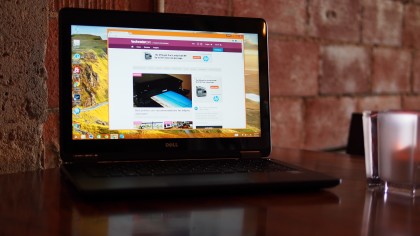
The upside is that the screen on the Latitude can tilt further than both these rivals. With a 180-degree tilt, allowing for better screen sharing and collaboration in one-on-one or small group meetings.
Also, even though Dell rates the brightness of the the 1080p display on our review unit at 350 nits, the screen seems a lot brighter. On competing notebooks, I found that I usually increase the brightness to between 50% and 70% indoors to get rid of glare and 80% to 100% outdoors when working under a bright sun. On the Latitude, I can keep the screen to about 30% to 40% indoors, and 50% to 70% outdoors.
The 12.5-inch screen sizes feels a lot less cramped than the smaller 10.8-inch Dell Venue 11 Pro 700 Series ($749, £488, AU$1,007) and the 11.6-inch Apple MacBook Air. I still wish Dell had gone with a taller screen, like that on the 3:2 aspect ratio on Microsoft Surface Pro 3 ($799, £520, AU$1,075) or the 16:10 of the MacBook rather than video-centric 16:9 ratio. Even though a taller screen would lead to letterboxing while watching videos, it would make working with large Excel spreadsheets easier with less vertical scrolling.
For multimedia, the Latitude has downward-firing speakers at the front. The speakers are loud with good audio fidelity, even at high volumes.
Keyboard and trackpad
Typing on the Latitude took a little bit of time to get used to coming from a larger 15-inch MacBook Pro. The keys on the Latitude's keyboard are 1/16 inches smaller than the chicklet-style keys on the MacBook Pro, and key spacing is also slightly reduced.
However, once I got used to the key size and spacing, typing is an absolute joy on the Latitude with springy, responsive keys. Key travel is satisfying with just the right of level of stiffness so that the keys don't feel mushy, and there is a reassuring level of "clickiness" to the keys when depressed.
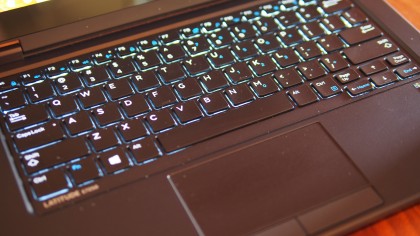
The soft touch finish on the keyboard deck also helps with the typing experience as the material feels nice on my wrists. When you first power on the laptop, the area doesn't feel too cold compared to an aluminum deck, and after prolong use the area doesn't get hot, making for a very comfortable experience from the moment you power up the Latitude to the moment you shut down your notebook.
After a week with this notebook, I can say that Dell has created my favorite laptop keyboard.
On the other hand, the trackpad is good, but could be better. The trackpad supports gestures, such as scrolling and pinch-to-zoom, but the tracking area is smaller than on a MacBook. One reason for this is that Dell didn't go with a large, clickable trackpad. Instead, there are two hardware buttons below the trackpad for left and right clicks. Unlike the Lenovo ThinkPad T450s, the Latitude does not come with a trackpoint.
Current page: Specifications, security and performance
Prev Page Introduction and design Next Page Verdict